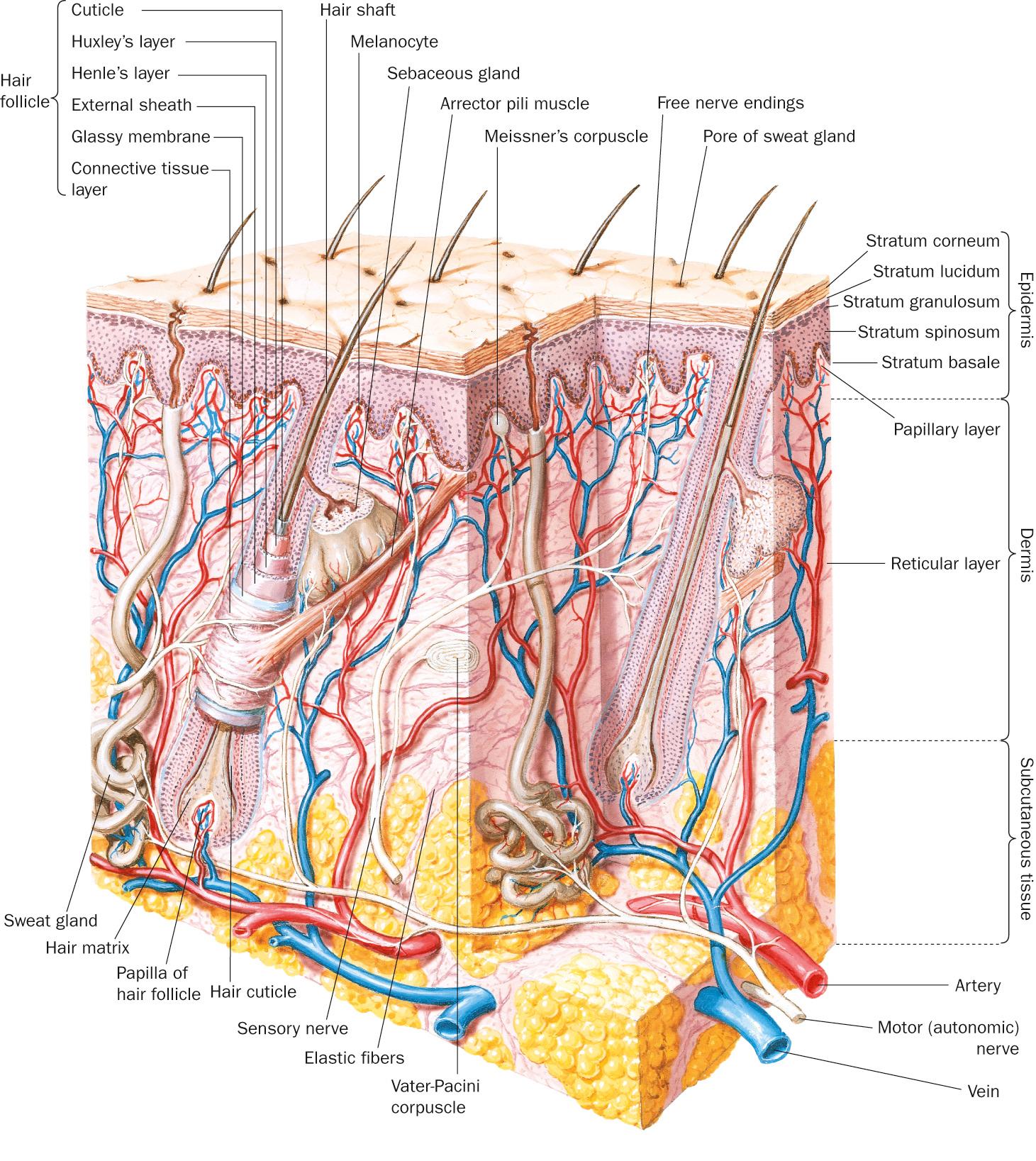Physical Address
304 North Cardinal St.
Dorchester Center, MA 02124

The skin assists in fluid homeostasis and protects against infections, toxins, and harmful effects of ultraviolet radiation.
The outermost layer of the epidermis, the stratum corneum, provides this protection through an impermeable barrier made up of fatty acids, cholesterol, and ceramides cemented between tightly knit, protein-rich cornified cells.
Keratinocytes serve skin barrier functions by contributing to the physical barrier as well as to the skin's innate immune defense (e.g., antimicrobial peptides, cytokines) and adaptive immune response.
One goal of topical or systemic dermatologic therapy is to restore and maintain the essential functions of the skin barrier.
For most individuals, full-body daily bathing is not necessary for healthy skin.
Patients should use mild soaps and cleansers, such as Cetaphil, Dove, Keri, Oil of Olay, or CeraVe, and should avoid excessive use of exfoliating scrubs, washcloths, and brushes.
Soaps with fragrances and antibacterial agents can be irritating.
Patients should bathe with tepid water and avoid washing with very hot water.
Bleach baths ( ![]() –
– ![]() cup bleach added to half to full adult bath) are antimicrobial and anti-inflammatory and are useful for patients with infected eruptions, such as atopic dermatitis and stasis dermatitis. Bathe for 10 to 20 minutes twice weekly to daily. Skin should be moisturized after bathing.
cup bleach added to half to full adult bath) are antimicrobial and anti-inflammatory and are useful for patients with infected eruptions, such as atopic dermatitis and stasis dermatitis. Bathe for 10 to 20 minutes twice weekly to daily. Skin should be moisturized after bathing.
Aluminum acetate solution (e.g., Dumboro) and vinegar compresses soothe the skin when used for acute eczema and allergic contact dermatitis.
Avoid bubble baths and fragranced bath oils because they can cause skin irritation and allergy.
When bathing children, use soaps and shampoos at the end of the bath to minimize skin dryness.
Apply moisturizers immediately after bathing and drying to trap in moisture.
A moisturizer is a compound that serves five principal functions: repairs the skin barrier, maintains skin integrity and appearance, reduces transepidermal water loss, restores the lipid barrier's ability to hold and redistribute water, and reduces skin inflammation.
Occlusive moisturizers, such as petrolatum, act by preventing water loss from the skin. Lanolin, mineral oil, and silicones (e.g., dimethicone) are other occlusive moisturizers.
Humectants, such as glycerin and hyaluronic acid, function by increasing absorption of water from the air to the epidermis.
Emollient creams and lotions soften and smooth the skin and thereby improve the skin appearance.
Immediately after washing, the skin should be patted dry and a moisturizer applied.
Pure petrolatum is thought to be the least irritating moisturizer.
Thick emollients, such as petrolatum, feel “greasy” and can block follicular and eccrine openings, producing acne and miliaria in rare cases.
Lotions spread easily on the skin, but are not as effective in preventing water loss and skin protection as petrolatum and heavier creams.
In some patients, preservatives (e.g., isothiazolinone) in creams and lotions cause skin irritation and allergic contact dermatitis.
Patients with sensitive skin should apply lotions free of dyes and fragrances.
Unscented soaps and moisturizers can contain masking fragrances, producing skin allergy.
Many creams and lotions have “antiaging” additives, such as vitamins A, C, and E, but their efficacy is not proved.
Sunscreens are added to many creams and lotions to slow skin aging.
Avoid applying moisturizers with sun protection factor at night.
Keratolytic emollients containing glycolic acids (lactic acid, salicylic acid) and urea are useful to gently exfoliate the skin.
Sarna (camphor and menthol) and Pramosone (pramoxine and hydrocortisone) are examples of lotions with additives to decrease itch.
Moisturizers decrease skin inflammation through barrier-enhancing properties.
Atopiclair (2% glycyrrhetinic acid and shea butter), MimyX ( N -palmitoylethanolamine), and EpiCeram (3 : 1:1 ratio of ceramides, cholesterol, and free fatty acids) are nonsteroidal creams able to improve inflammatory skin conditions, such as atopic dermatitis.
Eletone is 70% oil in 30% water produced with “reverse emulsion” technology, affording the physiologic benefits of an ointment with the consistency of a cream.
Promiseb and Loutrex are moisturizers with anti-inflammatory and antifungal properties that have been shown to improve inflammatory conditions, such as seborrheic dermatitis.
Patients should check with their physician for specific skin care recommendations.
In addition to those named here, many other effective products are available.
Neutrogena Norwegian Hand Formula
Theraplex Eczema Therapy
Mustela Lipid-Replenishing Balm
Vaseline petroleum jelly
Aquaphor ointment
Eucerin cream
Hydrolatum
Acid Mantle
Cetaphil cream (many formulations)
DML cream
Moisturel cream
Nutraplus cream
Aveeno Eczema Therapy
CeraVe cream
Vanicream Moisturizing skin cream
Cetaphil lotion
DML lotion
Nutraderm lotion
Curel lotion
Aveeno lotion
CeraVe lotion
Vanicream Lite lotion
Become a Clinical Tree membership for Full access and enjoy Unlimited articles
If you are a member. Log in here